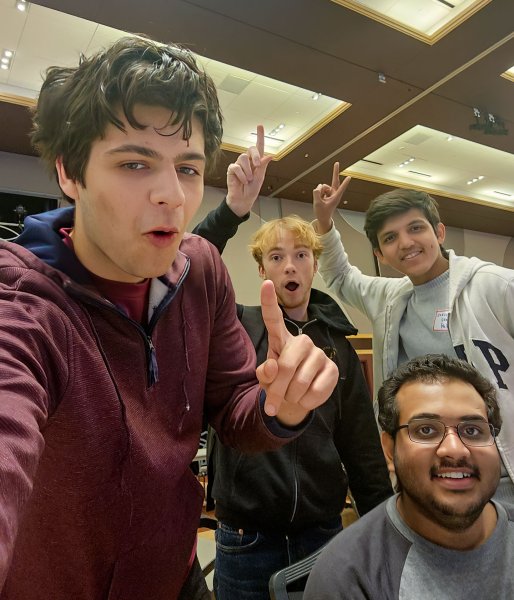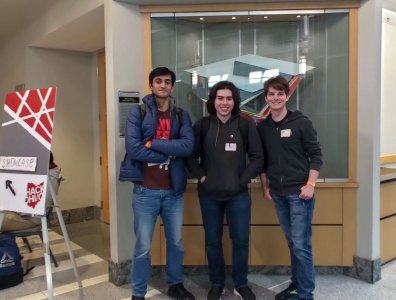Hackathon Heroes
Ohio Wesleyan Students Earn Awards at 2022 HackOHI/O Event

Name: Dhruv Sekhawat ’26
Hometown: Indore/Madhya Pradesh, India
Majors: Computer Science and Data Analytics
Minor: Economics

Name: Inesh Tickoo ’26
Hometown: New Delhi, India
Majors: Computer Science and Psychology
Minor: Sociology and Anthropology
Their Experience
Sekhawat and Tickoo participated in the 2022 HackOHI/O event, a 24-hour innovation and coding marathon held at The Ohio State University. The hackathon attracts more than 800 participants each year for a weekend of “coding, learning, networking, and innovation” as they create technology projects from scratch in response to a selected challenge.
“Hackathons are timebound, typically 24- or 48-hour competitions where the goal is to create a functioning software or hardware project that solves a particular problem or serves a cool purpose,” Tickoo explained.
Sekhawat and Tickoo participated on different teams and in different challenges, with Sekhawat’s team, “Whatever is Good with Me,” winning first place and sharing $1,000 in Amazon gift cards. Tickoo’s team, “Lorem Ipsum,” earned fourth place in its challenge.
Their Challenges
Sekhawat’s team participated in the American Electric Power (AEP) challenge and included OSU students Eric Boschert, Henry Redder, and Nilay Patel. Tickoo’s team worked to create a better way to schedule online meetings and included first-year OSU students Alex Gulko and Jackson Hicks.
Sekhawat: “Our goal for the AEP challenge and our project included building a website to graph trends between the power output of multiple wind turbines and their correlation with many confounding factors.
“These included average component temperature, runtime, vibrations, wind speed, and more. To build this website, the team used python with NumPy and matplotlib to analyze data and generate various plots. For the front-end design, the team used HTML, CSS, and JavaScript with the chart.js library.”
Tickoo: “We chose the problem of not being able to schedule meetings with people because of conflicting schedules and solved that problem by creating a website and an algorithm that took each person’s Google Calendar schedule (using Google API) and suggested the blocks of time (in a certain timeframe) when everyone would be available to meet. This way, you wouldn't have to worry about finding common availability and wouldn't need to share your calendar, letting others invade your privacy. We did this in the span of just 24 hours sitting in one hall with several hundred people – from ideation to prototyping to actually building and deploying our project.”
Lessons Learned
Sekhawat: “I learned how to not give up at any point in time, and I also learned that innovation with the use of data can create sustainable solutions to problems in the present and future.”
Tickoo: “Our fourth teammate left in the middle of the hackathon as they had academic priorities that they didn’t inform us of earlier [and] this fourth teammate had a major chunk of the project. … However, we came together in the middle of the night, re-prioritized our tasks, and redistributed work among the remaining three of us.
“Whenever I do hackathons, I usually do the User Interface Design work – which is essentially just designing the architecture of the website and making a properly usable and aesthetically-pleasing design layout of the website or app before the coders actually develop it. However, for the first time, I ended up actually coding half of the website on my own, and it was a truly amazing experience. I learned that I can accomplish any task I want to, given my willpower is at par with the stakes.”
Favorite Moments
Sekhawat: “The food and the activities were the best places to go to refresh our minds during the 24-hour-long event. Also networking with different companies about internship opportunities.”
Tickoo: “My personal favorite moment was when we got the algorithm running 25 seconds before the project submission deadline, and I loved how we were all so calm under pressure till the very last moment.”
Why Ohio Wesleyan?
Sekhawat: “I chose to attend Ohio Wesleyan because of the small class sizes and the small campus community.”
Tickoo: “I chose Ohio Wesleyan because I wanted to pursue interdisciplinary academia. As I mentioned, I’m planning to study across the fields of Computer Science, Psychology, and Sociology/Anthropology. Doing so would put me at an intersection of these three fields, and I would learn to understand their behavioral patterns better and use this understanding to design software, websites, and products with supreme user experience, usability, usefulness, accessibility, and the customer experience in general.
“Another major reason for me to choose OWU was that I received the Schimmel Family Foundation Scholarship, which covers my entire tuition and also includes a $20,000 research grant for pursuing off-campus research opportunities.”
Future Plans
Sekhawat: “My plans after graduation are to become a data scientist and help the world revolutionize development.”
Tickoo: “My plans after graduation are to work as a user experience designer/researcher, and if I choose to go to grad school, I would want to study human-computer interaction.”
